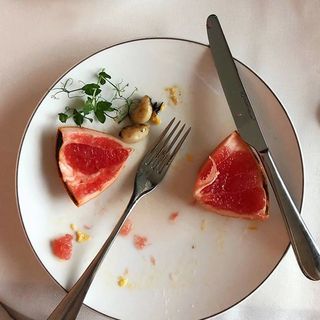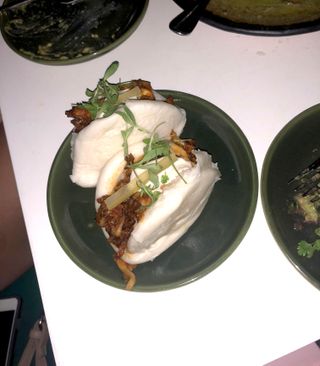How to Be a Part-Time Vegan (If Full Time Feels Like Too Much)


Let's be really honest: Being vegan once you already are vegan is easy, but the prospect of going vegan, especially if you've been a meat eater your whole life, can seem intimidating. This is especially true since (again, being really honest) vegans can be pretty militant, adhering to the idea that if you're not going to commit to the lifestyle 100%, why bother? "Some vegans believe it must be an all-or-nothing decision, but I like to focus on progress, not perfection," says Newport Beach–based registered dietitian Dahlia Marin. "Progressing to a flexitarian, possibly pescatarian, lacto-ovo vegetarian, or weekend vegan is still going to make a wonderful impact on health, the planet and its resources, and undue animal suffering."
"Flexitarian," "weekend vegan"—these aren't terms you normally hear. But according to Marin, becoming a "part-time vegan" is a completely legitimate and admirable move. "It's absolutely realistic for someone who hasn't wrapped their head around being fully plant-based," she says. And you can still reap many of the vegan benefits without going all the way; we're talking increased energy, faster recovery from exercise, a clearer complexion, improved digestion, better bone and heart health, lower cancer risk, and protection against preventable chronic diseases like type 2 diabetes, high cholesterol, and high blood pressure (not to mention the satisfaction of knowing you're doing something good for the animals and the planet).
Don't be discouraged by the prospect of fully committing to veganism, because research shows that even going 50% plant-based could have enormous benefits. "According to Oxford academic Dr. Marco Springmann, if the world transitioned to a vegan diet by 2050, the global economy would save $1.1 trillion dollars, considering decreased healthcare costs, greenhouse emissions, and environmental savings. Even if everyone became a 50% vegan by then, we would gain 50% of that economic benefit and make a significant impact on health and wellness," Marin explains.
If you're curious about transitioning to a more plant-based diet but don't want to go all the way, we're here for you. Keep scrolling for five easy starter tips for going part-time vegan.
1. Start Off With Meatless Mondays
There are a lot of hidden non-vegan ingredients in seemingly plant-based foods (honey, gelatin, whey), and if you're new to reading labels and ingredient lists, making sure everything you put in your mouth is animal product-free can seem overwhelming. So ease yourself into slowly: "Plan meatless days in your week: Start with meatless Monday; then increase to Monday and Friday; then Monday, Wednesday, and Friday; and continue to build from there," Marin suggests. Or try making just one meal per day 100% plant-based. Eventually you'll get a better handle on what you can eat, and avoiding animal-based foods will become effortless.
2. Get Into the Mindset of Plants Over Protein

"Non-vegans often believe they'll become malnourished, fatigued, and lose muscle when transitioning to a plant-based lifestyle," says Marin. "This couldn't be further from the truth!"
Most Americans grow up thinking protein should be the center point of their meals, but modern nutritionists know better. Plants are the way to go. "I suggest that everyone—whether they're vegan or not—fill at least half their plate (or more) with non-starchy vegetables like cauliflower, leafy greens, Brussels sprouts, broccoli, and asparagus," says integrative clinical nutritionist Jennie Miremadi.
You'll need to eat a higher volume of vegetables to feel as full (veggies are less calorically dense), but ultimately the vitamins, minerals, fiber, and phytonutrients will help you feel fuller longer, especially when combined with smaller amounts of plant-based healthy fats and protein.
3. Look to Social Media for Recipe Inspo
At a loss for delicious non-boring vegan recipes? When eating salad and fruit gets boring (and it will pretty quickly), just look to YouTube, which has a wealth of amazing vegan cooking and recipe inspiration (my favorite vegan YouTube channels are Hot for Food, Sarah's Vegan Kitchen, and Sweet Potato Soul).
Following these channels on Instagram and bookmarking vegan blogs like Epicurious and Oh She Glows will give you so much inspo you'll wonder why you ever felt like you needed animal products. "When you see a dish that looks delicious, add it to a list of recipes you want to try," Miremadi suggests. "Commit to making at least one of the recipes on your list each week. And then start incorporating the ones you love into your regular diet."
4. Experiment With Vegan Protein Substitutes

It's amazing how flavoring plant-based proteins using the same spices and condiments you'd use for animal protein can make vegan meals uncannily meat-like and delicious. "Substitute meatless protein in your favorite meals: Add chickpeas instead of tuna to salad, use tofu instead of chicken in a stir-fry, use black beans in chili instead of ground beef, and use lentils to make sloppy Joes," recommends registered holistic nutritionist Karen Gilman.
Tempeh, seitan, and jackfruit are also extremely satisfying meat-like plant ingredients that you can incorporate into tacos and burgers. As for vegan versions of your favorite dairy-based sauces, our experts have advice there too: "Rather than having that creamy, dairy-based dressing, try one that's made with tahini, cashews, or avocado," says Miremadi. (Check out this amazing list of vegan sauce recipes.)
5. Make an Effort to Expand Your Palate

Eating more plants doesn't have to be icky and scary—treat it as an opportunity to amuse your taste buds. "I often challenge my clients to try one new vegetable every week," advises registered dietitian Staci Gulbin. "Perhaps when they were a child they once ate mushy green beans, so now they can't even look at them. Instead of living with this aversion, I challenge them to try that same vegetable cooked in a different way, such as roasted green beans or green beans steamed with a drizzle of olive oil and ground pepper. Over time, you'll find that following this challenge will expand your plant-based palate."
Next up: Two vegan editors share their favorite plant-based recipes.
Disclaimer
This article is provided for informational purposes only and is not intended to be used in the place of advice of your physician or other medical professionals. You should always consult with your doctor or healthcare provider first with any health-related questions.

Who's your beauty icon?
Tie among Linda Rodin, Hari Nef, and David Bowie.
Who are your 5 favorite people to follow on Instagram?
@petracollins @katiejanehughes @alwaysjudging @bonnyrebecca @hotdudesreading
What's the beauty essential you can’t live without?
If I have some brow gel and Sisley's Phyto-Lip Twist, I'm good to go forever.
What's your desert island album?
Death Cab for Cutie's Transatlanticism
What's your favorite Byrdie.com story?
Game of Thrones's Nathalie Emmanuel looks so achingly beautiful in our feature with her that I think it's gonna have to be that!

